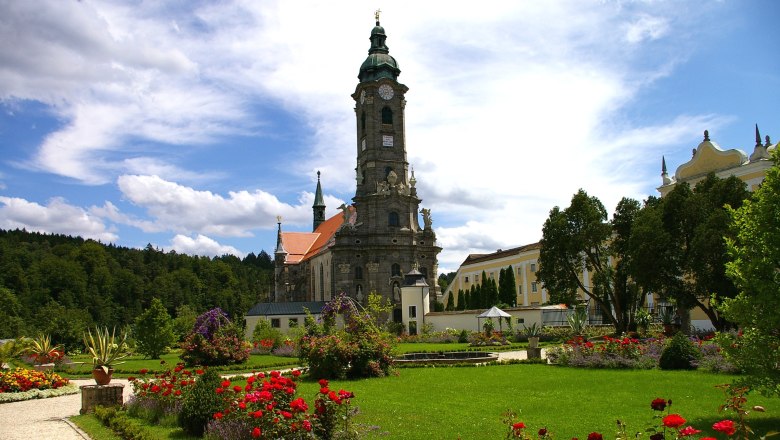Cistercian Monastery of Zwettl
A Baroque treasure in granite gray – a place that touches the soul.
Set amidst idyllic forests, river landscapes and fields, Zwettl Abbey invites us to turn inward and reflect – pastoral care is the paramount concern here. The power and tranquility of the medieval Cistercian monastery make a deep impression on visitors, the gardens take them straight to paradise. The abbey church, the Egedacher organ and the tower facade draw all eyes upward, eliciting a feeling of pure cultural delight.
Cultural treasures thousands of years old
The Zwettl monks devote themselves primarily to pastoral care. Their history began in 1138. Hadmar I of Kuenring founded a monastery near the town of Zwettl, bidding Cistercian monks from Heiligenkreuz to come to the Waldviertel. They erected the monastery’s medieval buildings and laid an economic foundation based on land cultivation. Battered by wars and waves of reformation in the 15th and 16th centuries, the monastery entered a period of decline. It was not until the mid-16th c that Zwettl Abbey began to flourish again. At the end of the 18th c, political pressure mounted, giving way to a far-reaching change in monastic life. The monks increasingly turned to providing pastoral care for the 15 parishes entrusted to them. The monastery made it through both World Wars and the Nazi period undamaged. In the 1990s, the abbey established an institution of higher education focusing on the environment and economics. Its education center, Bildungshaus, has been active in adult education for nearly a century. The abbey’s two economic pillars are forestry and fish farming. Following extensive renovations ending in 2013, the abbey shines in new splendor.
An art historical gem
In terms of art history, the abbey has outstanding examples of medieval architecture: cloister, lavatorium, chapter house, dormitorium, scriptorium and necessarium. In the course of the large-scale conversion of the monastery to Baroque style under Abbot Melchior Zaunagg, the church also took on a new appearance. A monumental tower facade was built to receive visitors and the dominant interior features became the imposing high altar, 16 side altars, the choir with inlay work and the famous Egedacher organ. Your eyes are inevitably drawn upward as you walk through the church. A new library was also created, with Paul Troger brought in to decorate the five vault severies with frescoes depicting the deeds of Hercules. The treasure chamber provides insights into the spirituality of earlier times. You feel a sense of wonder at every step here.
Paradise abloom
The Prelate’s Garden is just one of the blossoming marvels to behold. With their own hands, the monks have lovingly created a number of other spaces all around the monastery that feel like paradise on earth. They have always been places of peace and reflection, enjoyment and relaxation. Revitalized in accordance with historical documents, they invite us to linger and stroll. Here you can shut out all the noise and simply be for a change. The south-facing terraces are planted in herbs, fruits and vegetables. The Hildegard of Bingen Garden, the kitchen garden and the herbarium there make us want to sample all this bounty. The small herb garden is laid out in keeping with Goethe’s theory of colors and is perfect for quiet mediation.
Enjoyment Baroque style
The abbey is the ideal summer destination for lovers of Baroque music. At “Internationale Konzerttage Stift Zwettl”, the abbey church and library offer the perfect settings for unforgettable concerts. The small abbey shop offers delicious tidbits of a different kind. In a word, Geras is a slice of heaven on earth.
